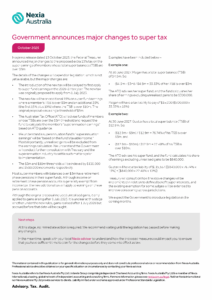In a press release dated 13 October 2025, the Federal Treasurer announced major changes to the proposed extra 15% tax on the super earnings of members whose total super balances (TSB) are over $3m.
The details of the changes will depend on legislation, which is not yet available, but the major changes are:
- The introduction of the new tax will be delayed to first apply to super fund earnings in the 2026-27 tax year. The new tax was originally proposed to apply from 1 July 2025.
- The new tax will be an additional 15% on super fund earnings where a member’s TSB is over $3m and an additional 25% (the first 15% plus 10%) where the TSB is over $10m. The original proposal was a single threshold of $3m.
- The Australian Tax Office (ATO) will advise funds of members whose TSBs are over the $3m threshold and request the fund to calculate the member’s “superannuation earnings” based on ATO guidance.
- We understand a superannuation fund’s “superannuation earnings” will be “based on the fund’s taxable income.” Most importantly, unrealised gains will be excluded from the earnings calculation. We understand the Government will conduct further consultation with Treasury and the superannuation industry to settle such matters prior to implementation .
- The $3m and $10m thresholds will be indexed by $150,000 and $500,000 increments respectively.
Most super members with balances over $3m have retirement phase pensions in their super funds. Although income on retirement phase pension accounts is generally exempt from income tax, the new additional tax will apply to earnings on these pension accounts.
Although the original proposal included unrealised gains, it only applied to gains arising after 1 July 2025. It is unclear at this stage whether under the new rules, gains realised after 1 July 2026 but accrued before that date will be caught .
Examples have been included below –
Example one:
At 30 June 2027, Megan has a total super balance (TSB) of $4.5m. So:
- ($4.5m – $3m) / $4.5m = 33.33% of her TSB is over $3m
The ATO advises her super fund, and the fund calculates her share of earnings excluding unrealised gains to be $300,000.
Megan will have a tax liability to pay of $15,000 ($300,000 x 33.33% x 15%)
Example two:
At 30 June 2027, Gustav has a total super balance (TSB) of $12.9m. So:
• ($12.9m – $3m) / $12.9m = 76.74% of his TSB is over $3m, and
• ($12.9m – $10m) / $12.9m = 22.48% of his TSB is over $10m.
The ATO advises his super fund, and the fund calculates his share of earnings excluding unrealised gains to be $840,000.
Gustav will have a tax liability of $115,557 ([$840,000 x 76.74% x 15%] + [$840,000 x 22.48% x 10%])
Treasury will consult on how the above changes will be implemented in relation to defined benefit super interests, and the existing exemption for some judges will be extended to improve consistency across jurisdictions.
We expect the Government to introduce legislation in the coming months.
Next steps
At this stage, no immediate action is required. We recommend waiting until the legislation has passed before making any changes.
In the meantime, speak with your local Nexia adviser to understand how the proposed measures could impact you, to ensure that you have sufficient time to plan for the changes before they come into effect as law.
Government announces major changes to super tax
Download PDF








